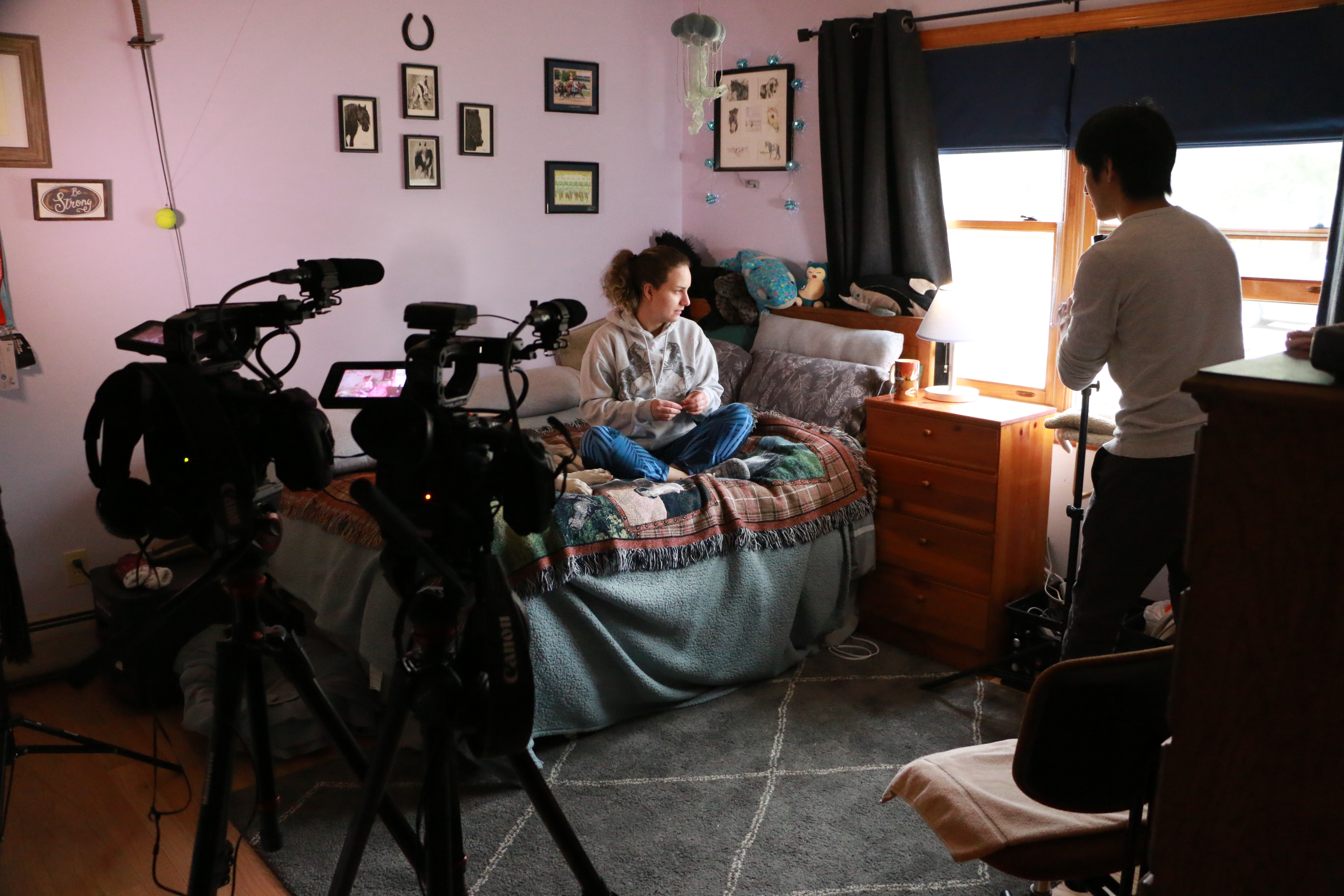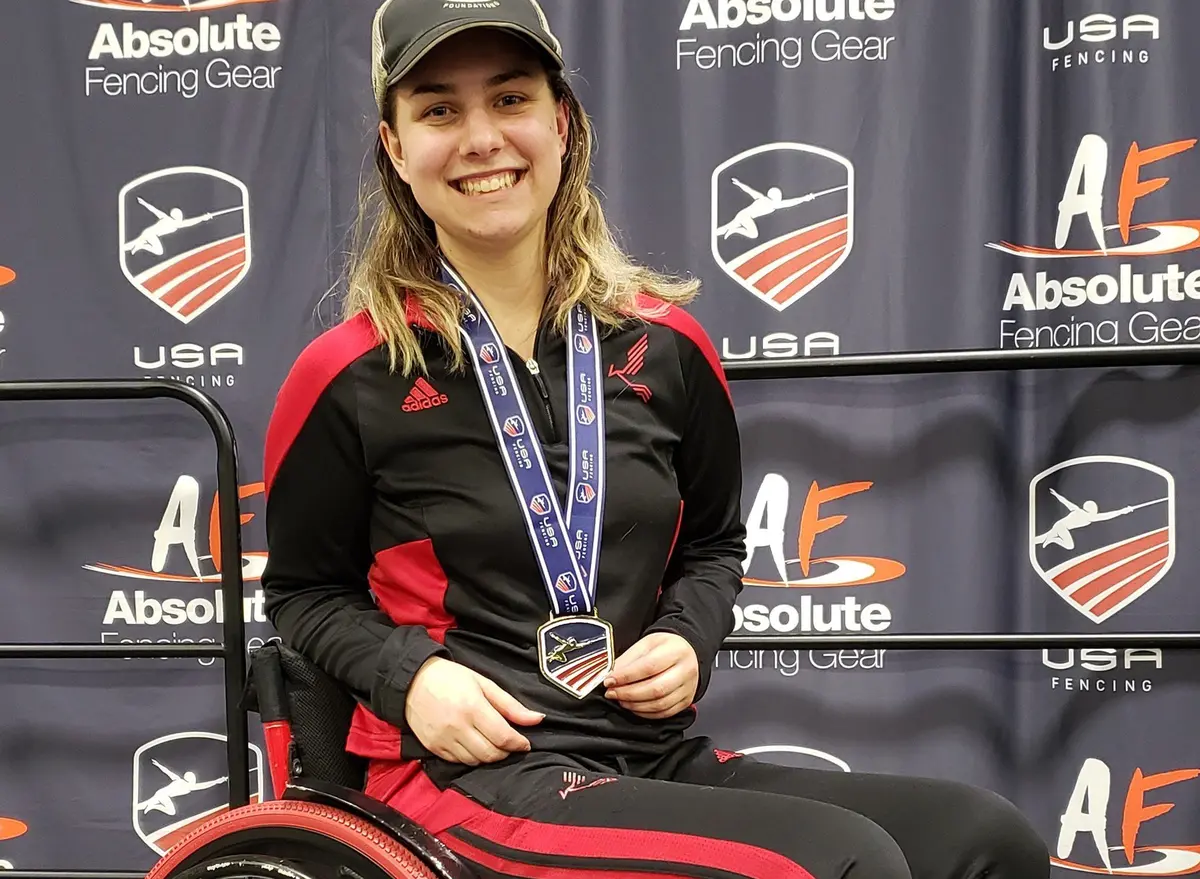
I.
I first met Victoria Isaacson, an international wheelchair fencer, on a cold, wet November night in 2019 at Lucky Orphans Horse Rescue, a ranch near the Connecticut border in Dover Plains, New York. I couldn’t immediately see why she was a wheelchair fencer. She was walking. She was handling horses. No wheelchair in sight. She said that’s a common response. She calls it her hidden disability.
At initial glance, Isaacson is a healthy 21-year-old woman who happens to work a tough manual labor job. She was wearing a black riding coat, shimmering with moisture from the rain, weathered jeans, and worn-down cowboy boots riddled with dirt and mud from a long shift. Her frizzy brunette hair with streaks of blond hid beneath a faded ball cap. I knew from photos that she had a large half-sleeve tattoo on her upper right arm. A Japanese-style black ink tattoo of whale sharks and humpback whales, her two favorite animals. Isaacson carries herself with authority. Her presence draws the eyes to her face, warm smile, and friendly eyes. She laughs and jokes often, making light of her circumstances. She’s not particularly tall, but her personality takes over a room. I almost didn’t notice the brace on her left leg.
We left the confines and smells of the neighing animals in the main barn and made our way upstairs to her large, one-bedroom apartment. But her ascent seemed labored, each wooden stair an obstacle to overcome, her gait now noticeably constrained by the leg brace, the obvious indication of her disability. But strangely enough, my eyes weren’t drawn to it until that moment.
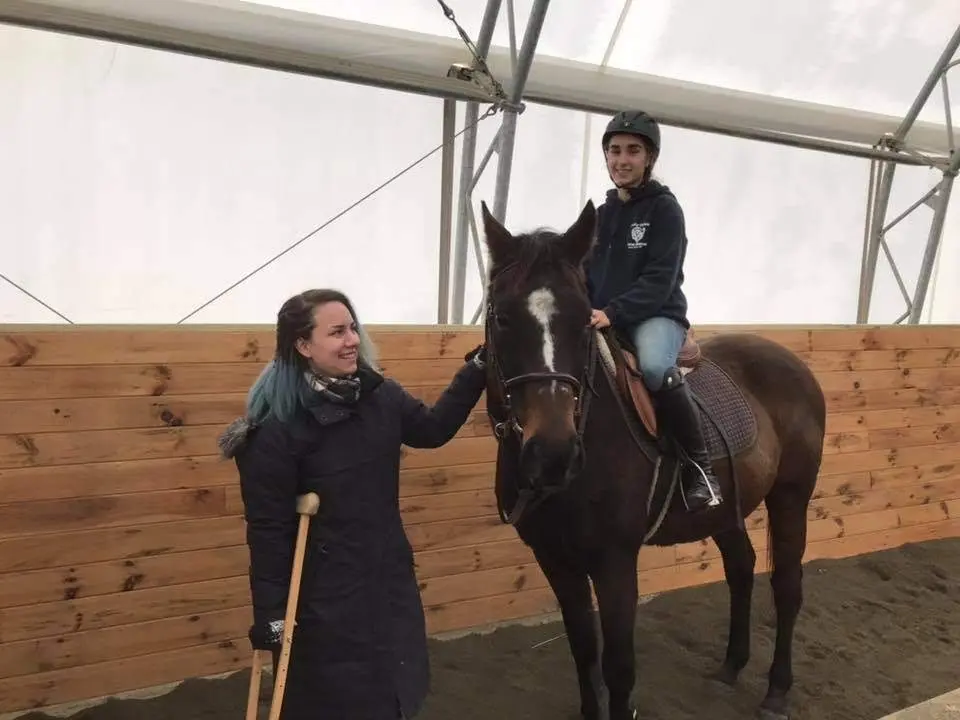
Ehlers-Danlos Syndrome, or EDS, affects everyone differently. According to the Ehlers-Danlos Society, the disease is genetic and affects as many as 1 in 5,000 people. There’s a range of symptoms. Isaacson’s includes hypermobility of the joints—or “stretchy” joints, as she says.
“I was born without a collagen factor,” she said matter-of-factly. “When you don’t have a collagen factor, your ligaments and your joints don’t connect properly. So my ribs have shifted and torn apart and re-formed themselves. I dislocated my elbow a lot when I was younger. My jaw is permanently dislocated.” She motions to her jaw bone with a near shrug. “My spine is completely straight in spots, and I have bulging discs, so nothing holds itself together.” All this means she’s prone to dislocation and subluxation, which is a slight misalignment of the vertebrae. And those are just the symptoms of her EDS.
The disease often leads to other rare, secondary neurological conditions. As of now, several years after her EDS diagnosis, Isaacson has lost feeling in much of the left side of her body—from her toes up into her hands—and she has decreased muscle function. She has trouble focusing her eyes.
In the course of our conversation, Isaacson slowly removed her leg brace, piece by piece. It seemed to me that she was breaking free of her bonds, but her obvious relief couldn’t mask the intermittent hints of pain across her face. Isaacson made no fuss and didn’t pause to acknowledge it, but when I pressured her, she said, “I pretty much live in constant pain. The brace helps me walk, but it’s breaking down.” The brace is no match for the rough work on the ranch. “My dad’s designing me another one. Insurance won’t cover a new brace yet.” Leg braces aren’t cheap. A new one can run upwards of $2,000. It’s another hurdle in her EDS journey.
“I always joke with my parents that this will probably kill me at a young age, so they shouldn’t worry too much,” Isaacson said, smiling. “But they don’t find that as funny as I do.”
II.
The magnitude of Isaacson’s health problems became clear during a December 2015 fencing tournament, when she was 17 and able-bodied. In the middle of a match, she began shaking uncontrollably and collapsed to the ground writhing in pain. “I was put on seizure precaution and was in the hospital for three days,” she recalled. Until then, her symptoms had been mild and she brushed them aside.
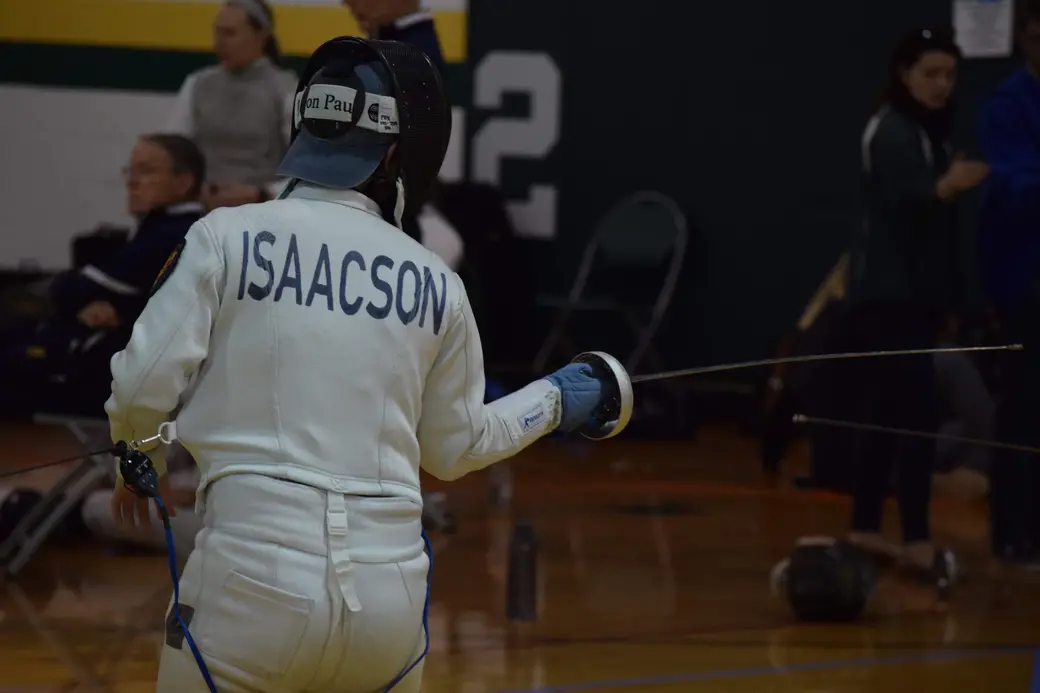
It took more than three years to determine what, exactly, was wrong. Her neurologists ruled out multiple sclerosis and ankylosing spondylitis (a spinal arthritis), but they weren’t any closer to a positive diagnosis.
By that time, Isaacson was an undergrad at Stony Brook University on Long Island. Having started in a health sciences track at a research school, she decided to take the diagnosis into her own hands. She went to the school library’s database and used her health knowledge to compile her symptoms, making a list of potential diseases she might have.
After countless hours researching, doctor’s visits, and medical tests, she scheduled an appointment with a specialist, who eventually concluded she had Ehlers-Danlos Syndrome.
A wave of relief washed over her. “Having the diagnosis made me feel validated, because my whole life I knew something was wrong,” she said. “All this time, everyone’s saying, ‘You’re fine. There’s nothing wrong. It’s all in your head.’ So it’s kind of nice having that.”
The relief was short-lived. EDS and its accompanying neurological disorders began taking their toll on Isaacson’s physique. “In the past four or five years, I’ve been watching my body slowly decay,” she said nonchalantly. “I watched my ribs separate and watched myself lose weight and not be able to gain weight. I was almost 160 pounds of solid muscle and I watched my muscle wither away. No matter how much I kept lifting, how much I ate, I lost 25 percent of my body weight in two months.”
Apart from the toll on her body, EDS affected her career aspirations. “It took away what I wanted to do,” she said. She wanted to become a physical therapist, but that role requires some level of physical fitness to succeed, as PTs treat actual physical injuries directly. She’s now looking into occupational therapy, which takes a more holistic approach to healing patients and doesn’t require as much hands-on treatment.
III.
The next time I saw Isaacson was a few weeks later. She had just returned from a wheelchair fencing world cup in Amsterdam. This was at the end of November 2019. I had planned to visit her at the ranch near Connecticut again, but she sent me an email saying she had to leave her full-time position as barn manager and was living back with her parents in Poughkeepsie.
Her left hip had atrophied in Amsterdam, the result of loading too much weight on her right side, she realized. It’s always a concern when fencing in a wheelchair. The flight from New York to Amsterdam was a little over seven hours. For someone with her condition, that’s a long time to sit, and it compounded the problem.
Within an hour of returning from Amsterdam, Isaacson was in an urgent care facility. She recorded a video sharing details about her symptoms, something she does often. “Hip gave out walking,” she says in the video, her voice low, muted, and tired. “So I have to think about career paths again and maybe going back to school, because clearly I can’t keep doing the barn work anymore. My right knee is going to go out any day now, and my left shoulder is going to go out. And that’s just from walking around a little bit and doing very minimal lifting at the World Cup.” In the video, Isaacson’s typically chipper disposition had taken a melancholic tone. It was the first time I had seen the conditions get the best of her.
Outside of fencing, Isaacson’s life has revolved around animals, specifically horses on the ranch where we first met. For her to admit she wouldn’t be able to manage the Lucky Orphans Horse Rescue anymore was stunning to hear.
Isaacson started working with horses when she was five and, by her recollection, she hasn’t stopped since. She got involved with the Lucky Orphans Horse Rescue when she was about 12. “I learned how to ride horses,” she told me when I visited her parents’ Poughkeepsie house. “I learned how to care for them, and everything that involves horses really became part of my life.”
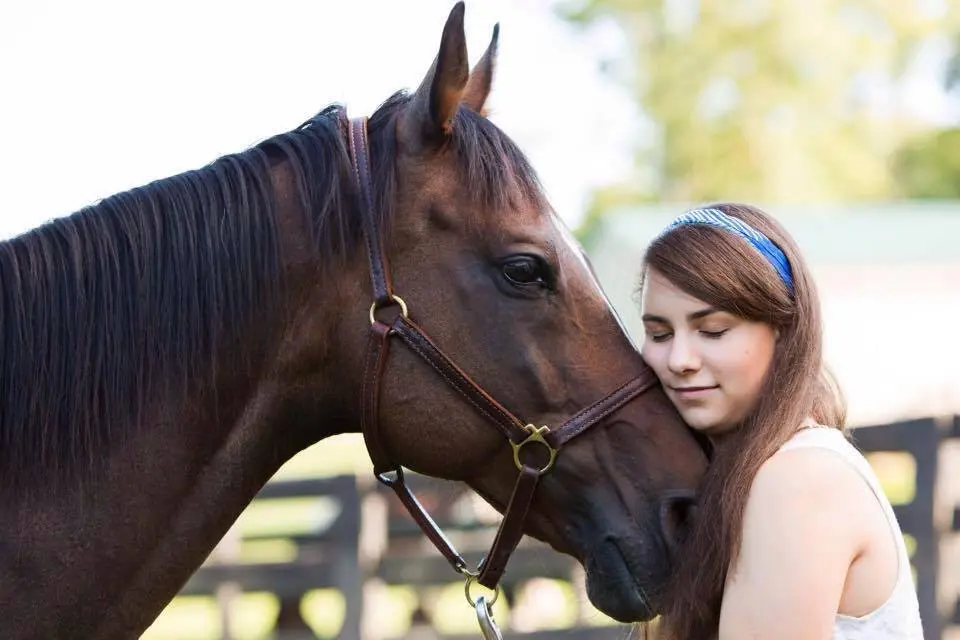
Walking through the front door, the first thing one sees are walls adorned with Isaacson’s horse paintings. Her bedroom is an altar of sorts to her two passions, horses and fencing. Her bed is covered in a magnificent heavy blanket stitched with horse imagery. There are photos of Victoria and her horses from over the years on every wall. A stuffed toy horse rests on her dresser. Horse figurines decorate her closet shelves. Riding ribbons are everywhere.
Giving up her managing job at Lucky Orphans Horse Rescue was painful. The ranch was so fond of Isaacson that it asked her to stay on and switch roles to something more accommodating for her disabilities.
Isaacson moved into a part-time role, working about 11 to 15 hours a week doing paperwork. “It is kind of depressing,” she said. “I used to be handling these animals all the time. I had just started working with a horse and having a relationship with him, but it’s not safe for me to work with him anymore. So it’s very hard to go there and not be able to work with the horses.”
The United States is one of a few countries where the Olympics and Paralympic teams aren’t federally funded, which means the athletes often pay their own way to train, travel, and qualify. As such, Isaacson has no choice but to keep working so she can fund her fencing exploits.
“My disability progressing was kind of awful, but also a blessing in disguise for my fencing, because now I have time to just train all the time,” Isaacson said.
IV.
Victoria Isaacson first got into fencing in her early teenage years. A friend in Poughkeepsie asked her to try it out and she instantly fell in love. Her friend quit, but Isaacson kept at it. After the first lesson, she said to her coach, “I only want to fence and play with ponies.”
Her coach, Eric Soyka, has been a big influence on Isaacson’s life. It was Coach Soyka who first noticed something was wrong with Victoria. It started with minor observations: her back leg didn’t seem as strong; her actions weren’t as powerful as they had been. Then, in 2017, the fencing tournament incident happened. The sudden loss of her power and strength was enough to send Isaacson into a bout of depression.
She locked herself in her room and shut herself out from everything. In her mind, her life of riding horses and fencing was over. Coach Soyka, as Isaacson recounted, came to her house and physically dragged her back out into the world. He helped her learn to get back to doing what she loved. And he introduced her to the sport of wheelchair fencing.
Making the switch into wheelchair fencing presented some obvious challenges. “When I was an able-bodied fencer, I used my legs for everything,” Isaacson said. “Everything I did was footwork based where I would move in the space and then out of the space and lunge.”
As she recounts these memories, you can almost see it in her eyes. She’s reliving those moments. Days gone by of the power and quickness on her feet. “I used my legs and I had really big thighs. I was very strong. And then I started losing the use of my legs and then had to switch over to wheelchair. And suddenly, I can’t hit the foot anymore. And I can’t run away and you’re in this tight space.”
Fencing has three weapons and three different sets of rules; saber, épée, and foil. Isaacson wheelchair fences in the épée and foil disciplines. When she speaks of hitting the foot, Isaacson is referring to the ability to strike an opponent on any part of the body when fencing épée. Now, she’s only allowed to hit an opponent on the hand or the torso, a far cry from the full body. “It’s a completely different game. I had all the base techniques and I had to change how I applied them,” she said. “I’ve been doing wheelchair for two years now. And it took me about two years to get used to it. And that’s why it’s taken me so long after seven years of fencing to really start getting results.”
Her results are promising. Isaacson currently fences on Team USA with a goal of qualifying for the Tokyo 2020 (now 2021) Paralympic Games and Paris 2024. “It took me about six months after switching over and then I was able to go to my first two world cups and show I wasn’t getting pummeled,” she said with a laugh. “After that, I was invited to some Colorado training camps and that’s really kind of solidified my spot on Team USA.”
Colorado Springs houses the U.S. Olympic Training Center, so an invite there was no small feat. “We’re such a small community. If you’re willing to put the hours in and show improvement and go to tournaments and improve by training, then you can make it as far as you want.”
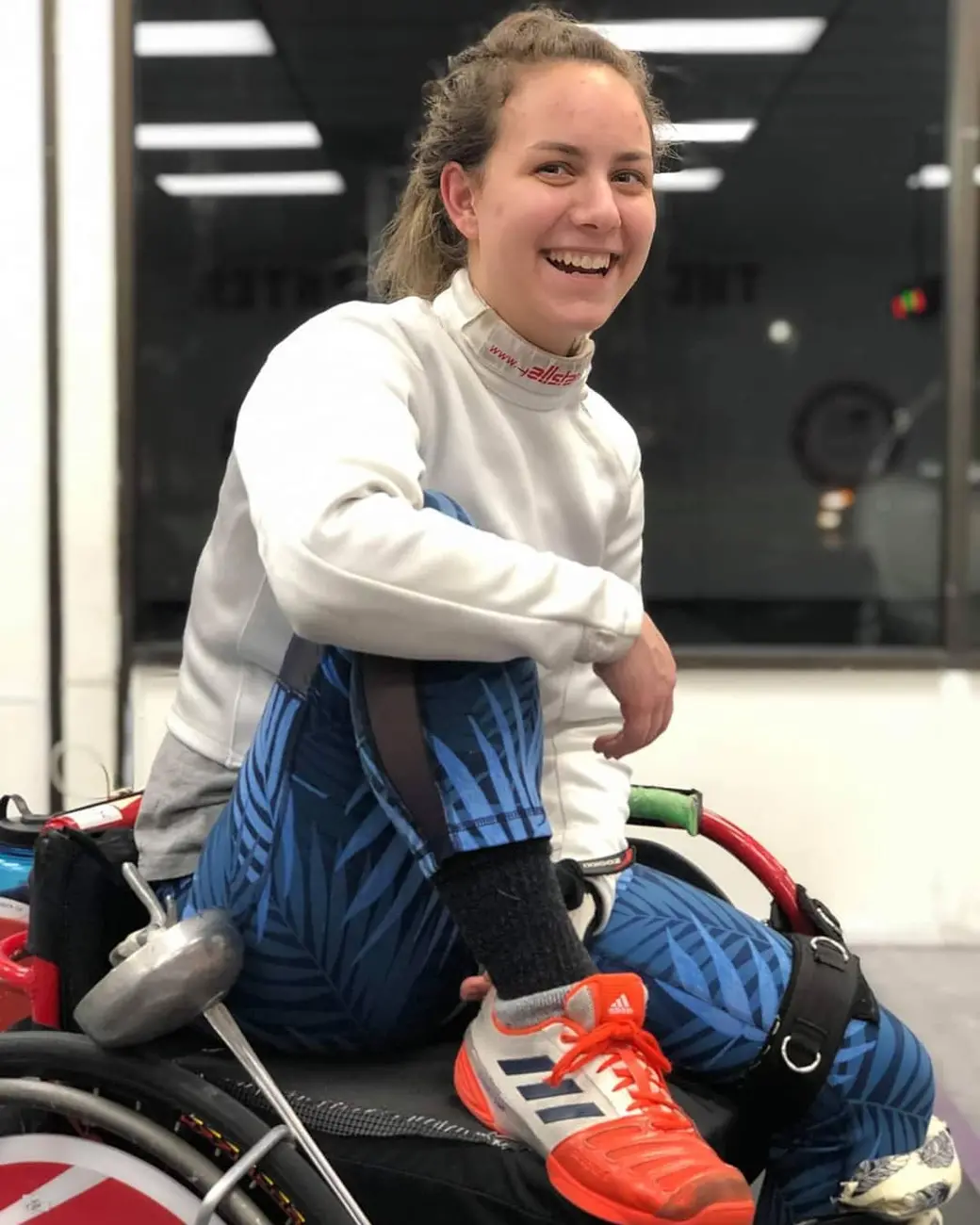
Isaacson was 27th in the world in the épée and foil combined rankings prior to the postponement of tournaments around the world due to coronavirus. She has to be in the top 25 to qualify for Tokyo.
If she’s nervous, she doesn’t show it. For her, it’s just one day and one tournament at a time.
Her next chance to improve her standing was supposed to be at the São Paulo World Cup and America Zonals, back to back tournaments. Those were postponed from March 2020 until March 2021. The postponement shifted rankings and moved Isaacson into 26th place. Once the Paralympics were delayed shortly after, Isaacson was unsure where her ranking landed and what the new process would be. Regardless of the delay and uncertainty, she refocused on training.
In preparation, Isaacson fences on an almost daily basis. Prior to the shutdown, if she wasn’t training at the Phoenix Center in Poughkeepsie, she was volunteer coaching at Vassar College just down the road. Once COVID hit New York, she continued fencing in a basement gym she created during quarantine. Her coach would give her lessons over Zoom.
V.
The next time I met Isaacson was early December 2019, at her parents’ Poughkeepsie house. She spent much of the day scheduling doctor visits and then calling her insurance provider to cover those doctor visits. In the early evening, she began getting ready to volunteer coach at Vassar College. She was wearing dark gray athletic shorts and a white “Team USA” t-shirt.
It was the first time I saw her tattoos in person. Her right upper arm covered in the sea life I had seen in photos. Her left thigh covered in faded blue forget-me-nots, red peony flowers, and cardinal feathers. They were originally done with color ink when she was 18, but she suspects the color faded quickly because of her collagen skin issues.
“I was going to do a whole flower leg, but since I wear the brace or I’m constantly covering the leg with some kind of compression, I can’t ever get it touched up,” she said. “I kind of like the faded look of it. Now it kind of shows how much healthier I’ve become even though my disability is getting worse.” She said she doesn’t get pneumonia or the flu nearly as often as she used to so she views her current status as healthier overall.
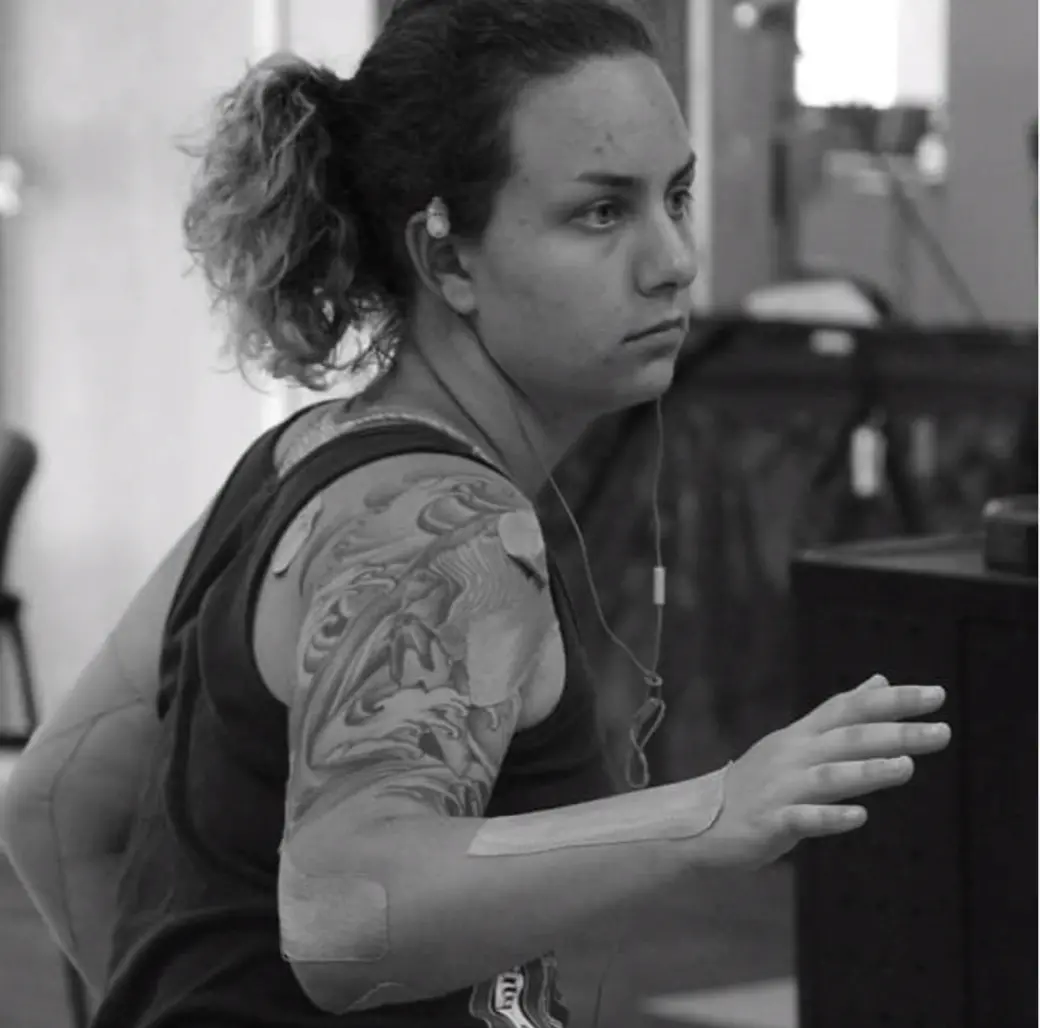
After covering her left leg in a compression wrap, she began placing athletic tape around her right knee. She explained that the tape keeps her hyper-flexible knee from bending the wrong direction as she coaches. We then drove to Vassar where she forwent the wheelchair. She grabbed just one crutch from her car to stabilize her walk. She knew she’d be on her feet most of the session.
Vassar’s head coach, Bruce Gillman, is excited to see Isaacson enter the large gymnasium. His athletes are competing in an upcoming tournament and two of them have never fenced saber before. It’s Isaacson’s job for the night to give them a crash course in the discipline. She doesn’t get paid for this role, but she finds the extra fencing she gets in beneficial. “It gives them experience fencing in a close combat situation, which they don’t usually experience,” she explained.
She stood there, leaning heavily on the one crutch for support, and walked the two girls through the motions of saber fencing. Isaacson showed her attentive audience how to hold the saber, where to strike the opponent, and how to properly move their feet for the lunge. As I observed, I finally noticed the toll of the muscle atrophy of her left side. Her left leg was noticeably skinnier than her right. Her arms, however, have the opposite problem. Isaacson is a right-handed fencer so her right arm is much larger than her left, but that’s due to the bigger workload on that arm.
After Vassar’s session, Isaacson drove just a few minutes up the road to the Phoenix Center, her primary training facility. The group of fencers already at work gave her a warm welcome. It’s immediately clear there’s a strong community here. Members helped Isaacson secure her heavy red fencing wheelchair onto a black wooden platform with weights and straps so it wouldn’t tip over during the bouts. Coach Soyka was there, going from fencer to fencer for one-on-one lessons. Waiting for her turn, Isaacson recruited some of the able-bodied fencers to try their luck against her.
They were no match for Isaacson’s skills. Isaacson, in her large metal wheelchair, the opponents, in a small wooden stool, sat just at arm’s reach from each other. Each bout lasts under a minute. Isaacson’s skill is evident as she lunges forward in her chair, allowed to only lift one butt cheek up, striking them above the hip for a point. Some of the younger fencers were intimidated to face her, knowing they would likely lose by a lot. They did.
VI.
Victoria Isaacson’s exterior is a tough outer shell composed of resilience and perseverance, traits developed out of necessity through her life.
In a recent online interview conducted during quarantine, Isaacson finally acknowledged this facade, a rare occurrence. “I don't like to show emotions and I like to appear like I have it all together because then people respect me and listen to me more,” she said.
Prior to any knowledge of her EDS, Isaacson was diagnosed with chronic Lyme disease around the age of 13. “Any time I showed weakness or any sign of being sick, people took advantage of that. And then kind of left me on the sidelines or started rumors about me for no reason,” she confessed. “So I was out of class a lot. By my senior year of high school, I really didn't have any friends.”
Once her EDS symptoms fully emerged and amplified, the depression set in. As an athlete, it was especially difficult to accept her new reality. Isaacson would put herself between a wall and her bed “because when you're depressed, you don't do anything. And that's just something people don't want to talk about.”
Then and now, Isaacson keeps herself busier than most people through fencing, coaching, her job, and graduate school. She admitted the lack of free time is a way to help her cope. “If I live my life saying, ‘You've got this. You're gonna be okay. You're doing the best you can,’ then every day will be better. So I try not to allow myself to slump. And no matter how much I want to stay in that bed, I force myself to get up.”
Her best way to battle the depression was by trusting the process and not worrying about the outcome. That’s something Coach Soyka taught her through fencing. “And then I was able to learn to love myself again,” she said. “You are good enough. You can do things if you just care about how you get there, not so much the end result.”
VII.
This was the Victoria Isaacson of late 2019 and early 2020, before everything changed with coronavirus. Though the world was largely altered, Isaacson’s routine was not. She continued fencing through quarantine and she continues fencing almost daily. After shifting her career multiple times due to Ehlers-Danlos Syndrome, she decided to apply and was accepted into an occupational therapy PhD program at Quinnipiac University in Connecticut. She moved there in late July 2020 to start a hybrid model of virtual and in-person coursework. As for fencing, she still drives back to New York when she can to train at the Phoenix Center.
She recognizes her path to the Tokyo 2021 Paralympics is difficult—and perhaps unlikely—at this point, but she shrugs it off. Paris 2024 is right around the corner.
It’s clear Isaacson is at home while fencing in the Phoenix Center. It’s clear she was home with the fencing team she coached at Vassar College. She’s home when she’s doing the sport she loves. It’s her escape from the pains of EDS. Her escape from health problems and a world of uncertainty.
She couldn’t work with horses anymore, but she simply pushed forward and moved on, something she must do constantly. She keeps her perspective upbeat and positive. She goes shopping and sees movies with friends. She once revealed to me, with a wide smile, how she snuck candy and water into a screening of Frozen 2 because “nobody ever checks my wheelchair backpack.”
She doesn’t know what the future holds, but for now, Victoria Isaacson is just a regular 22-year-old as she sees it. Her next step is to keep working.


